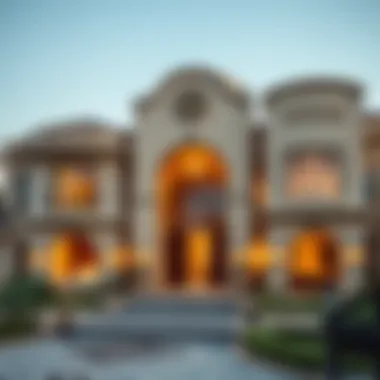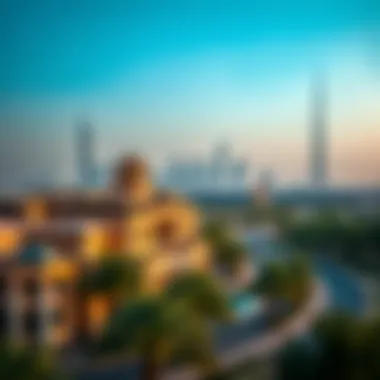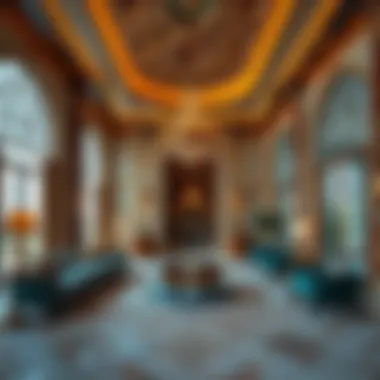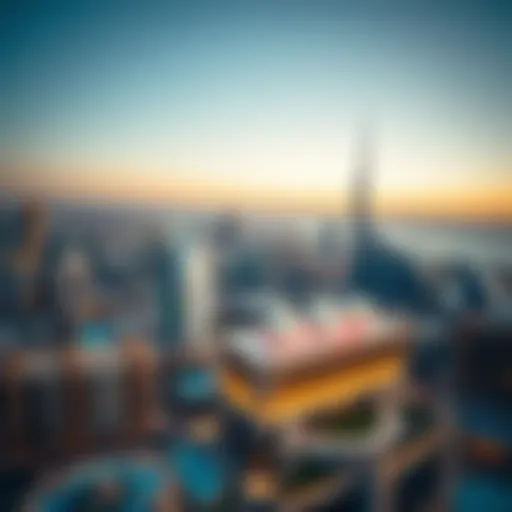Exploring Arabian Estates in Dubai's Real Estate Market


Intro
The landscape of Arabian estates in Dubai embodies a unique blend of luxury and cultural heritage, standing as both a testament to the city’s rapid growth and a beacon for international investors. As Dubai continues to flourish, its real estate market has not just expanded but transformed, becoming a playground for affluent buyers and investors. Here, the confluence of modern architecture and the rich narrative of the region showcases properties that are not merely buildings, but intricate stories waiting to be explored.
This article aims to provide a thorough analysis of Arabian estates, uncovering the layers of significance they hold within the broader spectrum of Dubai's real estate market. From the distinctive characteristics that set these estates apart to current market dynamics and investment opportunities, we’ll leave no stone unturned.
The subsequent sections will delve into pertinent market insights, highlighting current trends and forecasting future changes, while also offering strategic advice for those embarking on their property investment journey in this vibrant city.
Prelude to Arabian Estates
Arabic estates, particularly those in the prime locales of Dubai, are not just mere structures; they embody a blend of tradition, luxury, and modernity. Understanding these estates is essential for several reasons, especially for investors and expatriates looking to make informed decisions in the burgeoning property market of the UAE. This section will lay the groundwork for the following discussions and highlight the intricacies involved in navigating Arabian estates.
Given the unique cultural and economic landscape of the region, these properties often come with their own set of characteristics, from traditional architectural elements to lavish amenities. Investors must grasp not only the physical aspects of these estates but also their investment potential, which can vary widely based on location and market dynamics.
In essence, an introduction to Arabian estates is vital because it frames the reader’s understanding of what makes Dubai’s real estate offerings stand out in an increasingly globalized market. The estates reflect the socio-economic evolution of the region, anchoring their importance in today’s investment landscape.
Defining Arabian Estates
Arabian estates can be defined as vast plots of land distinguished by luxurious residential properties that draw inspiration from Islamic architecture while incorporating contemporary design features. Generally, these estates exhibit a transcendent blend of aesthetics and functionality, often set within lushly landscaped gardens that create an air of tranquility that is hard to match. They stand out not only for their beauty but also for the lifestyle they promote, offering upscale amenities such as private pools, spas, and expansive living spaces.
These estates often house multiple properties and can vary significantly in size and architecture, catering to different tastes. Some may resemble traditional Arabian palaces with intricate tile work and elaborate domes, whereas others might favor a more minimalist, avant-garde style, appealing to modern sensibilities. Ultimately, defining Arabian estates involves looking beyond mere architecture to understand their significance in the broader context of luxury living in the Middle East.
Historical Context
The history of Arabian estates is steeped in narratives of wealth, cultural fusion, and architectural evolution. These properties have evolved over decades, reflecting the region’s transformative journey from sleepy desert communities to bustling economic hubs. Initially, traditional Arabian homes, or ‘Barasti’, were constructed from local materials and designed to withstand the harsh climate.
However, as trade flourished, especially during the oil boom of the 1970s, aspiring local and expatriate elites began investing in extravagant properties that mirrored Western luxury, yet incorporated unique Arabian aesthetics. This blending of styles not only resulted in increasingly grandiose estates but also laid the groundwork for today’s real estate market where Arabian estates are regarded as jewels of architectural prowess and opulence.
Moreover, the legal framework and regulations surrounding real estate have also undergone significant changes, allowing greater foreign investment and transforming the market landscape. With such a rich historical context, understanding Arabian estates requires diving into the past to appreciate their present significance in the dynamic real estate scene of Dubai.
The Architectural Essence of Arabian Estates
The significance of the architectural essence of Arabian estates cannot be overstated. These properties are not mere structures; they stand as a testament to centuries of culture, innovation, and the interplay between tradition and modernity. The design of Arabian estates is deeply woven into the fabric of the region's history, making it vital for investors and expatriates to grasp its nuances.
Understanding the architectural essence is not just about aesthetics; it's about comprehending the lifestyle these estates promote. Traditional designs often reflect the values and environment of the Arab world, offering open spaces, shaded courtyards, and intricate detailing that resonates with both the local climate and the culture. This rich architectural tapestry translates into significant appeal within the real estate market.
Design Influences
When it comes to the design influences shaping Arabian estates, several key elements stand out. The aesthetics typically intertwine a blend of Islamic architecture, contemporary styles, and local influences. The use of arches, domes, and ornamental motifs evokes a sense of heritage while integrating modern comforts.
- Cultural Significance: Designs often symbolize various aspects of Islamic history and artistry, from geometric patterns to arabesques. Each motif carries specific meanings, rooted in the area's rich past.
- Climate Adaptation: Properties are designed to maximize airflow and minimize heat, with high ceilings and strategic shading from sun exposure. This adaptation not only enhances comfort but also mirrors traditional living practices in desert environments.
- Community Orientation: Many estates feature communal courtyards or gardens, serving as spaces for social interaction. These spaces reflect the communal lifestyle prevalent in Arabian culture, fostering relationships among inhabitants.
The design influences serve not only aesthetic functions but also practical ones, catering to the demands of Arabian living while connecting residents to their cultural roots.
Materials and Aesthetics
The materials utilized in Arabian estates contribute immensely to their beauty and functionality. Local resources are often prioritized, providing authenticity and sustainability. Here are a few notable materials frequently employed:
- Natural Stone: Limestone and sandstone are commonly used due to their durability and thermal properties. They help in regulating interior temperatures, which is crucial for comfort in hot climates.
- Wood: Beautifully crafted wooden elements, often sourced from tropical countries, add warmth and character to interiors. Intricate carvings on doors and window frames exemplify craftsmanship and artistry.
- Glass: Expansive glass windows and doors, sometimes adorned with traditional motifs, allow natural light to fill spaces. This enhancement of light not only beautifies but also bridges the indoor and outdoor environments, promoting a sense of openness and connection to nature.
Current Market Trends


The landscape of Arabian estates is evolving rapidly, with market trends shaping the future for investors and expatriates alike. Understanding these trends is vital, as they not only provide insights into pricing strategies but also illustrate the shifting preferences of buyers in Dubai and the broader region. The current trends shed light on the dynamics of supply and demand, emerging neighborhoods, and the impact of legal regulations on property values. These factors are crucial for anyone considering an investment in the Arabian estate sector.
Price Dynamics
Price dynamics in Arabian estates are influenced by a myriad of factors, making them intriguing for potential buyers and investors. With property prices fluctuating based on market demand, economic conditions, and infrastructural developments, it is essential to grasp what drives these changes.
- Demand and Supply: The ever-growing demand for luxury properties and family-friendly developments has propelled prices. For instance, areas like Dubai Marina consistently see high interest due to their prime beachfront location, making them a hotspot for both local and foreign buyers. This demand often leads to competitive bidding, pushing prices higher.
- Economic Factors: The overall economic climate significantly impacts the pricing strategies for Arabian estates. During periods of economic growth, property prices tend to rise as more investors enter the market seeking attractive returns. Conversely, economic downturns may bring about price corrections, providing savvy buyers opportunities for potential bargains.
- Government Regulations: Local policies can have a profound effect on pricing. For instance, recent legislative changes aimed at easing regulations for foreign investors in the UAE have led to increased activity in the market, consequently driving up prices in certain sought-after areas.
"The complexities of price dynamics demand careful scrutiny, especially for those who wish to navigate the waters of Arabian estates effectively."
Investment Opportunities
When discussing investment opportunities in Arabian estates, it's crucial to highlight the diverse possibilities that are currently on offer. Understanding these can be the key to maximizing returns and aligning investments with individual preferences.
- Luxury Properties: The luxury segment has been witnessing a surge in interest, particularly among high-net-worth individuals. Palatial estates in neighborhoods like Palm Jumeirah are not just homes but status symbols. Investing in these high-end properties can yield substantial returns, especially given the allure of Dubai as a global hub.
- Emerging Neighborhoods: Areas like Dubai Creek Harbour and Dubai South present exciting investment opportunities as they are poised for substantial growth. Investing early in these neighborhoods, where prices are comparatively lower, can lead to impressive appreciation rates as infrastructure develops and attracts residents.
- Short-Term Rentals: Another avenue worth exploring is the holiday rental market. With annual events and tourists flocking to Dubai, properties in prime locations can be lucrative for short-term rentals, providing a quick return on investment while contributing to the local economy.
Legal Framework Surrounding Arabian Estates
Understanding the legal framework surrounding Arabian estates is essential for anyone wishing to navigate the complexities of the Dubai real estate market. When potential investors contemplate entering this vibrant market, grasping the regulations is not merely a formality; it is a cornerstone of strategic planning. The right legal knowledge can safeguard investments, clarify ownership rights, and smoothen the transactions process.
Regulations for Foreign Investors
In the past, foreign investment in the Dubai real estate market was heavily regulated. However, the scenario has shifted remarkably, enhancing its appeal to international buyers. Specific regulations now allow foreign investors to own properties in designated areas, making it easier for them to secure their investment.
An important legal aspect is the concept of freehold ownership, which allows foreigners to wholly own property, without the need for a local partner. This kind of ownership is mainly available in communities like Dubai Marina and Downtown Dubai. Understanding these regulations is crucial, as they vary significantly depending upon the area and property type.
Additionally, potential buyers must navigate visa regulations, which are linked to ownership. For example, owning property worth over AED 2 million can provide eligibility for a residency visa. Such regulations can accentuate the investment's appeal, as they lead to broader opportunities in terms of lifestyle and business.
Property Ownership Structures
Investors interested in Arabian estates should also familiarize themselves with the different property ownership structures available. In Dubai, property ownership can mainly be categorized into three structures: freehold, leasehold, and commonhold.
- Freehold Ownership: This grants total ownership of the property and the land it stands on. It's the most sought-after option among foreign investors since it provides complete control.
- Leasehold Ownership: This structure gives the buyer the rights to lease the property for a specific period, normally up to 99 years. After this time, the property reverts to the landowner. While still a valid option, it offers less security compared to freehold ownership.
- Commonhold Ownership: This is a newer concept in Dubai, focusing on properties with multiple owners, such as apartments. Owners have their units' freehold rights but share ownership of common areas.
Getting familiar with these structures helps investors understand their options based on individual financial plans and goals. It's worth consulting with a legal expert to navigate these waters safely and efficiently.
"Navigating the legal landscape is just as crucial as finding the right property. Knowledge is power in this complex market."
Neighborhoods Featuring Arabian Estates
The neighborhoods where Arabian estates are located pplay a crucial role in shaping their desirability and value. Each area comes equipped with unique characteristics that cater to different preferences, lifestyles, and investment goals. Understanding these neighborhoods can guide potential buyers and investors in finding the estates that align with their vision and financial objectives.
The Role of Dubai in Arabian Real Estate
Dubai has become synonymous with luxury and modern living. As a bustling metropolis, it acts as a magnet for expatriates and property investors. With its unparalleled infrastructure, cutting-edge design, and a melting pot of cultures, Dubai offers a vibrant backdrop for Arabian estates. The city's real estate market has witnessed explosive growth, largely due to visionary governance and favorable economic policies.
Property investment in Dubai is often viewed as a robust financial move, considering the government incentives aimed at attracting foreign investors. Additionally, the ease of accessibility to world-class amenities and recreational spots enhances its appeal. Investors looking for lucrative opportunities will gain a competitive edge by familiarizing themselves with Dubai's dynamic neighborhoods.
Noteworthy Communities
- Dubai Marina
Dubai Marina stands out for its stunning waterfront views and luxurious lifestyle. As one of the largest man-made marinas in the world, it offers residents a sophisticated living experience. Their glamorous surroundings feature high-rise towers and a plethora of dining and recreational options.A key characteristic of Dubai Marina is its blend of urban living with leisure activities, making it a popular choice among both locals and expatriates. A unique aspect is the walking promenade, where residents can socialize and enjoy the picturesque views of the marina. However, it’s essential to consider the potentially high rental prices, which can deter some buyers. Overall, Dubai Marina remains an attractive locale for those seeking a vibrant lifestyle. - Palm Jumeirah
Palm Jumeirah is iconic for its distinctive palm-shaped layout and luxury offerings. This architectural wonder hosts an array of upscale estates, resorts, and entertainment options. Whether you’re looking for a beachside villa or a lavish apartment, Palm Jumeirah has it all.One of the major highlights of this community is the exclusivity it affords to its residents. The private beach access and upscale amenities represent a lifestyle that many aspire to. Nevertheless, the initial investment here may be steep, presenting barriers for some potential buyers. The allure of living on an artificial island sets Palm Jumeirah apart, establishing it as one of Dubai's crowning jewels. - Downtown Dubai
Downtown Dubai serves as the vibrant heart of the city and epitomizes modern Dubai. Home to the Burj Khalifa and the Dubai Mall, this community attracts a diverse demographic eager to experience urban living at its finest.The accessibility to major landmarks and a bustling social scene makes Downtown Dubai a highly sought-after area. Its central location and mix of residential and commercial spaces create a lively atmosphere. However, potential buyers should be mindful of higher property costs due to this desirability, which can limit options for budget-conscious investors. This community’s dynamic energy and its fusion of work and leisure encapsulate what many consider the essence of Arabian estates.


In summary, understanding the neighborhoods where Arabian estates are situated is paramount for anyone looking to invest in Dubai’s thriving real estate market. Knowing the unique traits of each locality can deeply influence one's choice and investment strategy.
Property Management Considerations
Property management is a critical aspect when it comes to assessing the value and sustainability of Arabian estates. These estates represent one of the most lucrative investments in Dubai's vibrant real estate market. Managing these properties effectively is not just about keeping the buildings standing; it involves an intricate balance of maintenance, financial planning, and tenant relations.
Maintenance and Upkeep
The maintenance and upkeep of Arabian estates is paramount. Properties, particularly luxurious ones, need regular attention to retain their value. Routine checks can prevent small issues from snowballing into costly repairs. For example:
- Landscaping: Beautiful gardens contribute to curb appeal, but they require regular maintenance.
- Pool Care: Pools need to be cleaned and serviced often, ensuring they adhere to health and safety standards.
- Building Repairs: Timely addressing of cracks, leaks, or any wear and tear maintains structural integrity and prevents larger issues.
In Dubai’s climate, these factors take on added importance. The intense sun can lead to fading or deterioration of materials, while the humidity might affect systems and installations. Regular inspections help in optimizing these elements and can significantly enhance the estate’s overall appeal. Additionally, a solid maintenance regime is a strong selling point for potential renters or buyers, showing them that the property is well-loved and cared for.
Maximizing Rental Income
Maximizing rental income from Arabian estates involves strategic thinking and an understanding of the market dynamics at play. Investors must adopt a multifaceted approach to ensure they’re getting the best returns possible. Here are some key strategies:
- Market Research: Understanding what tenants are willing to pay and what amenities are in demand can guide pricing decisions.
- Renovations and Upgrades: Invest in high-quality finishes and modern features. This not only attracts higher-paying tenants but can also allow for premium pricing.
- Lease Management: Flexible leasing options can cater to expatriates who may have different needs. Short-term rentals can be lucrative, especially in desirable locations like Dubai Marina.
- Effective Marketing: Using platforms such as Facebook or real estate websites can give listings greater visibility. Having a professional showcase the property can also make a significant difference in attracting the right clientele.
Rental properties that are well-managed with clear financial strategies often see a lower turnover rate, enhancing overall profitability.
By prioritizing both maintenance and effective income strategies, owners can ensure that their Arabian estates not only retain their charm but also provide robust returns for the future.
The Future of Arabian Estates
The future of Arabian estates holds a wealth of possibilities and intrigues, echoing with the cadence of change prevalent in Dubai's thriving real estate sector. As we navigate the highway of urban development, it's crucial to understand elements influencing the trajectory of this market. Investors, expatriates, and real estate agents must brace themselves for significant shifts informed by both economic and environmental factors. This discourse is not merely an exploration; it centers on practical outcomes, strategic benefits, and key considerations regarding the transformation ahead.
Predicted Market Shifts
The heartbeat of any real estate market can be gauged through its adaptability to external pressures. The Arabian estates scene is no different. Several factors are currently at play that will impact how properties are valued, bought, and sold.
- Economic diversifications are crucial. With Dubai committing to reduce oil dependency, sectors like tourism, technology, and finance are expected to rise. This shift amplifies demand for residential and commercial estates, transforming the investment landscape.
- Interest rates and inflation are the ever-present specters in financial realms. Changes in these areas can dramatically affect buying power and investment intentions. While a spike might deter buyers today, it could lead to invaluable opportunities tomorrow, particularly in premium properties available at discounted rates.
"Observing the market means preparing for tomorrow's opportunities and challenges."
- Emerging demographics play a sizable role too. The influx of a more affluent, young, and globalized audience seeking home in Dubai is bound to change market dynamics. Expect a pursuit of amenities reflecting lifestyle preferences—like co-working spaces and eco-friendly designs.
Market observers are noting a trend toward flexible property options. With the rise of hybrid work models, short-term rentals and serviced apartments see increased demand, indicating a shift from traditional long-term leases.
Sustainability Trends
Sustainability in real estate isn't just a buzzword; it's swiftly becoming a pivotal selling factor. As global awareness heightens regarding ecological footprints, it has diversified the desires of investors. One can't really overstate how integral green living environments will become in shaping future developments.
- Energy Efficiency: Innovative materials and designs that champion energy preservation promote not just sustainability, but cost savings for residents as well. Arabian estates are increasingly incorporating smart home technology that optimizes energy consumption.
- Community Designs: The trend toward integrated neighborhoods featuring parks and fitness areas reflects a broader movement toward sustainability that values quality of life. Buyers are more inclined to invest in communities designed to foster well-being.
- Regulatory Changes: Expect governments to implement stricter building codes concerning sustainability. Such regulations may initially feel burdensome to developers but are vital pathways to responsible building practices.
Case Studies of Notable Arabian Estates
Examining case studies of notable Arabian estates provides a lens through which we can grasp the broader trends and nuances that shape the real estate environment in Dubai. Through these examples, we not only witness what makes some developments successful but also understand the specific factors that can lead to advantageous investments. These case studies serve as exemplary blueprints, shedding light on architectural innovations, investment strategies, and sustainable practices that can enhance property value.
Successful Investments


Successful investments in Arabian estates often stand out due to a myriad of factors, such as location, design, and marketing strategy. For instance, let’s consider the luxurious Burj Khalifa residences, which have become a hallmark of high-value living in Dubai. These homes provide stunning views and top-tier amenities, attracting wealthy expatriates and investors alike. The singular allure of living in the world’s tallest building has made this estate a desired property, demonstrating that iconic architecture can dramatically influence real estate success.
Another notable investment example is the villas in Palm Jumeirah, a man-made island that has captivated the market. Originally, the villas were marketed as exclusive holiday homes, but their unique positioning and charm have now turned them into sought-after permanent residences. Over the years, property values have soared, thanks in part to the development of nearby entertainment and dining establishments, enhancing the overall desirability of the area. This case is a reminder that successful investments often hinge on the ability to adapt to evolving market demands.
In addition to location and design, the integration of technology plays a pivotal role in successful investments. The development of smart homes in Arabian estates has seen a surge in appeal, corresponding with a growing desire for convenience and security. For instance, properties incorporating advanced security systems and energy-efficient technologies not only attract buyers but also retain their value more effectively in the long term.
Architectural Landmarks
Architectural landmarks greatly contribute to the identity of Arabian estates. They encapsulate the cultural heritage of the region while showcasing modernization through innovative design. One standout example is the Al Faisaliyah Center, which gracefully melds traditional Arabian aesthetics with contemporary functionality. The design elements reflect the heritage of the Saudi Arabian landscape while providing essential business and leisure spaces, making it a hub of activity.
On a broader scale, many structures in Dubai's skyline have now evolved into symbols of success—much like the Burj Al Arab, known for its distinctive sail-like silhouette. This architectural marvel serves not just as a hotel; it represents a vision of luxury and hospitality. Such buildings draw tourists and investors alike, leading to significant economic benefits for the region.
Moreover, as Dubai continues to grow, the incorporation of sustainable design elements in new estates fosters a healthier environment while enhancing the marketability of properties. For instance, eco-friendly materials and construction methods not only reduce the carbon footprint but can also be a selling point for environmentally-conscious investors.
By studying these architectural landmarks, one can appreciate context, design, and investment potential in Arabian estates. These case studies help investors discern which features truly add value, aiding them in making informed forecasts and sound investment decisions.
Challenges Faced in the Arabian Estates Market
The Arabian estates sector, especially in a bustling market like Dubai, stands at the crossroads of opportunity and complexity. This section delves into the significant challenges that investors and stakeholders encounter, illuminating the importance of understanding these hurdles for anyone involved in the real estate scene.
Market Volatility
Market volatility in real estate is a real beast, and the Arabian estates market is no exception. Prices can swing like a pendulum, influenced by various elements such as economic shifts, geopolitical tensions, and changes in consumer demand. An example of this can be seen during the global financial crisis, when property values plummeted, leaving many investors in disarray.
Potential property buyers must remain cognizant of these fluctuations.
- Economic Factors: The health of the overall economy, including oil prices and tourism rates, plays a pivotal role in market sentiment.
- Speculative Investments: Heavy speculation often leads to inflated property values, causing a sharp correction down the line.
- Changing Demographics: Shifts in the population, including an influx of expatriates or changing lifestyles, can alter demand dramatically.
Investors aiming for long-term stability often conduct thorough due diligence. The ability to anticipate market trends is crucial. Understanding statistical indicators and market reports can offer invaluable insights for navigating this capricious landscape.
Regulatory Hurdles
Navigating the myriad legal frameworks set up around real estate in Dubai is like walking a tightrope. On the one hand, there are numerous opportunities for overseas investments, but on the other hand, the regulatory environment can pose substantial challenges.
- Ever-Changing Regulations: The legal landscape in real estate can shift like sand in the desert wind, often making it critical for investors to stay updated on laws. New regulations can affect everything from property ownership rights to the rental processes.
- Restrictions for Foreigners: Although Dubai is welcoming to foreign investors, there are still certain limitations regarding ownership in specific areas. For instance, freehold properties are restricted to designated zones, which can narrow investment options for many.
- Taxes and Fees: Knowing about taxes like the property registration fee or municipality fees can be a maze for newcomers. These additional costs can impact the net yield on investments considerably.
As a rule of thumb, savvy investors engage legal counsel familiar with local laws to navigate these challenges successfully. It is crucial for anyone considering significant investments in Arabian estates to be strategic.
Key Takeaway: Awareness of market volatility and regulatory hurdles is essential for investors to manage risks effectively and make informed decisions in the ever-changing Arabian estates market.
Understanding these challenges is not just beneficial—it is vital for anyone looking to enter or thrive in the Arabian real estate arena. With diligent research and the right expertise, many investors can find pathways to overcome these obstacles, ultimately leading to rewarding opportunities.
End
The conclusion serves as a bridge, tying together all the threads woven throughout this article. It emphasizes the value of understanding the landscape of Arabian estates, particularly within the dynamic context of Dubai’s ever-evolving real estate market. Investors, agents, expatriates, and prospective buyers must grasp the nuances discussed, as these insights can inform their strategies and decisions in a region marked by both potential rewards and inherent challenges.
The significance of Arabian estates is multifaceted; they are not merely properties but cultural landmarks interspersed throughout Dubai. Ultimately, recognizing their architectural value, alongside current market trends, shapes how one approaches investment opportunities. Likewise, understanding legal frameworks affecting foreign ownership is paramount to ensuring a seamless investment experience.
Recap of Key Points
- Distinctive Characteristics: Arabian estates are emblematic of a unique architectural style that merges modern design withtraditional influences, setting them apart in the global real estate landscape.
- Current Market Dynamics: Trends indicate a fluctuating market influenced by various economic factors, including tourism and foreign investments. Buyers must stay informed to navigate these changes effectively.
- Legal Considerations: Understanding the legal framework governing property ownership is essential for foreign investors interested in securing land or property in Dubai. Regulations can vary significantly, affecting ownership structures.
- Investment Potential: Given their unique appeal, Arabian estates often present lucrative investment opportunities, provided investors conduct thorough research and ensure adherence to local regulations.
Final Thoughts on Arabian Estates
The Arabian estates of Dubai represent a compelling blend of cultural heritage and modern luxury. As the market continues to grow and adapt, those interested in this sector must remain vigilant, using the information presented in this analysis as a guiding compass. To be successful in this arena, a comprehensive understanding of the architectural essence, market trends, and regulatory landscape is crucial. Empowered by knowledge, investors and stakeholders can harness the unique potential of Arabian estates.
"To know where you’re going, you must know where you’ve been." Understanding the past and present of Arabian estates will guide future endeavors in this captivating segment of real estate.











